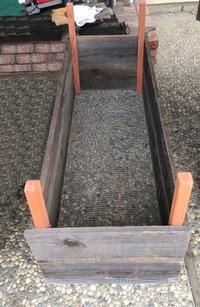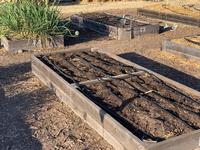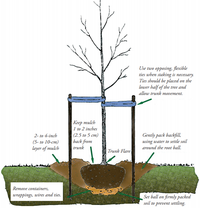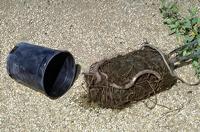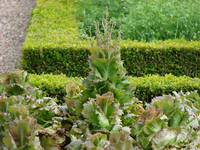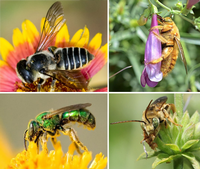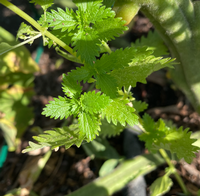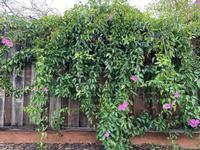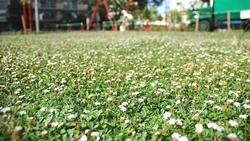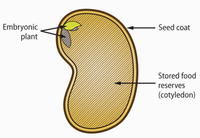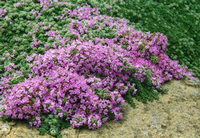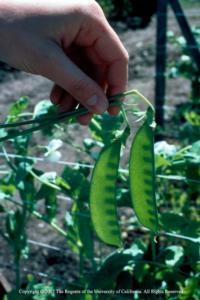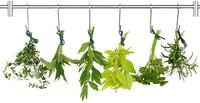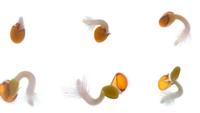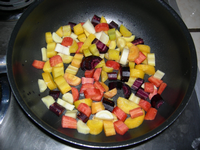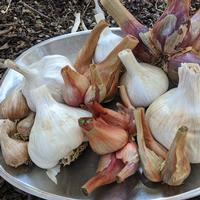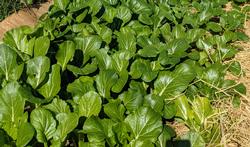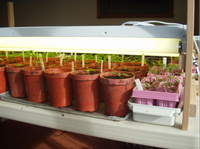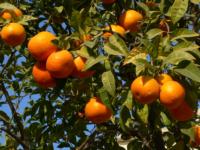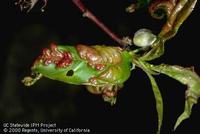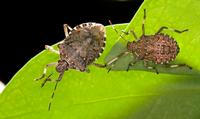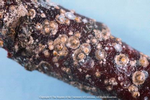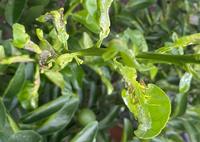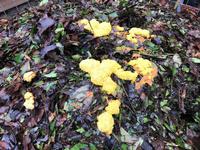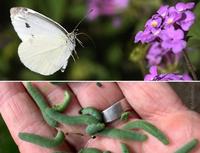March Tips
Monthly tips are categorized by To-Dos, What to Plant, or Pests and Diseases. Scroll through the list to see items in each category. Also, refer to our list of tips useful for any month.
1. To-do
-
Drought Tip - Laundry to Landscape Irrigation
- A laundry to landscape system is an easy way to save water in times of drought. It can be installed easily at a low cost to send rinse water from clothes washers directly to the landscape.
Suitable plants include fruit and ornamental trees, shrubs, and ornamental annuals. It’s not applicable where the water would come in direct contact with fruits or vegetables.
More information: Laundry-to-Landscape Graywater System
- March, April, May, June, July, August, September, Any month -
Pruning Dead Branches
-
As dormant trees and shrubs begin to leaf out, it will be fairly easy to see which parts are dead. Prune back to live wood to avoid diseases and keep your garden healthy. Swelling buds and a thin green layer just under the bark are signs that the wood is alive. Find tips on pruning at the UC Home Orchard website. If larger trees need pruning, hire a professional. The International Society of Arboriculture (ISA) has a searchable list of certified arborists.
- March, April -
Wet Soil
-
The clay soils which dominate our area are particularly susceptible to compaction, especially when they have received a lot of rain. These soils are characterized by small mineral particles. Hence squeezing out the air spaces makes it more difficult for plant roots and soil organisms to get the oxygen they need to flourish. Try to avoid walking on or using heavy equipment on soil that is wet. Digging in wet soil can also destroy the structure, breaking up useful soil aggregates and earthworm tunnels. Try to wait until the soil is moist, not wet or dry, for easiest tillage. If you must walk or stand on the soil, use a board to distribute your weight over a broader area. Mulch can also create a bit of a cushion and help minimize compaction.
- February, March, December -
Pruning Fuchsias
-
The time to prune fuchsias is early spring, after the chance of frost is past. If there is frost damage prune it out and take off some of last summer's growth. Leave at least two or three healthy leaf buds on each branch. Fuchsias have a tendency to get leggy. Frequently pinch the tips of the branches during the spring and summer to force side growth, making the fuchsia bushier. Pick off flowers as they fade.
More information: UC IPM list of common pests and disorders of fuchsias.
- February, March, April -
Soil Management - Compost vs Mulch
-
Many home gardeners are confused about the terms “compost” and “mulch;” frequently these terms are used interchangeably, but they are not really the same thing. Here is a Comparison of Soil and Mulch from UCCE.
Amend soil with compost to create soil that will retain water but still drain well enough for roots to have the air and water they need.
Benefits of compost
- Forms aggregate particles with clay
- Creates larger pore spaces for water & air
- Helps release nutrients from clay so that plant roots can absorb them
- Supports the soil foodweb by providing nutrients for the organisms
- Lowers pH somewhat.Benefits of mulch
Mulch does not get worked into the soil. It sits on top of your irrigation system and helps:- Control weeds
- March, April, May, Any month
- Prevent erosion
- Preserve soil moisture
- Keep roots cool and moist -
Keep Foliage after Bloom Fade
- To keep bulbs/corms/rhizomes/tubers blooming each year, leave the plant’s foliage in the ground long after the blossoms have withered. That’s because the foliage needs to photosynthesize to store energy in the bulb for next year’s blooms. Deadhead the spent flowers by cutting the stalks from the finished blooms all the way back to the base, Then wait for the foliage to die back and turn yellow before removing it. Some people tie the leaves together to tidy the garden, but that’s not advised because it limits the light needed for photosynthesis. As an alternative, intersperse annuals to hide the foliage until it can be removed.
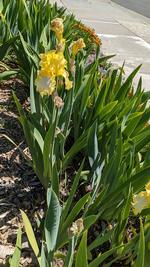
If the plants seemed crowded and the flowers were getting smaller, carefully dig them up, separate the bulbs, and replant them with greater spacing. Toss any bulbs/corms/rhizomes/tubers
that are mushy or show other signs of rot. And continue to enjoy easy-maintenance flowers year after year. More information: Basic Bulb Care
- March, April, May, June -
Growing Vegetables in Containers
-
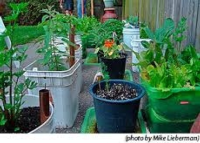 Container grown vegetables can be decorative as well as good to eat. Almost any vegetable can be grown in a container if given the proper care. Eggplant, peppers, tomatoes, lettuce, onions, carrots, cucumbers and herbs do well. Use our Vegetable Planting Chart to decide when to plant.
Container grown vegetables can be decorative as well as good to eat. Almost any vegetable can be grown in a container if given the proper care. Eggplant, peppers, tomatoes, lettuce, onions, carrots, cucumbers and herbs do well. Use our Vegetable Planting Chart to decide when to plant.One of the biggest problems is that containers dry out very fast and nutrients wash away. Both are solvable. Do not use clay pots, which dry out quickly. Plastic, composite or wooden half-barrels are good, but avoid dark colors that can absorb heat. Vegetables like a roomy container.
There must be drainage holes in the bottom but it is not recommended that you put pebbles or broken crockery in the bottom. Use a good commercial potting mix, not planter or planting mix. Group the containers together so they will shade one another.
The hot summer sun can heat the soil to unhealthy levels. Water whenever the soil is dry. You can test by digging your fingers into the dirt. You may have to water more than once a day. A simple drip system is easy to install and will make your container garden almost foolproof. Fertilize every week with a water-soluble fertilizer.
- February, March, April, October, November -
Poison Oak
-
Poison oak is a California native plant that provides shelter and food for many native birds and other creatures. The downside is that at least 75% of us develop allergic contact dermatitis to the plant. Unwanted poison oak can be pulled or dug up by allergy-resistant friends, remove plants in early spring or late fall when the soil is moist and it is easier to dislodge rootstocks.
A complete list of management options, including herbicide control, is contained in the UC Pest Note on Poison Oak. Under no circumstances should poison oak be burned.
- February, March, April, November -
Weed Management
- While some weeds are edible (purslane, nettles, dandelions, miner's lettuce), many are a nuisance and compete with your chosen plants for water and nutrients.
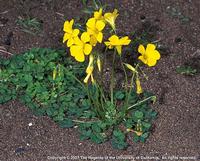 Photo: Oxalis pes-caprae aka Bermuda buttercup, by Joseph DiTomaso, UC ANRWhichever variation of “One year’s seeds makes seven years’ weeds” you prefer, the truth remains: a key part of weed control is not letting them go to seed. For best results, work on removing weeds before they are able to propagate. Hand pulling and hoeing are effective methods for killing many common weeds.- January, February, March, Any monthKnowing what kind of weeds you have and how it propagates can be helpful in choosing the best management method. If they propagate by seed, pull or hoe them before they flower and go to seed. If they re-grow from roots, pull up as much of the root as possible. Many weeds, like Bermuda grass, have multiple ways of multiplying. Only non-propagating parts are advisable to throw in the compost bin.More Information: UC Quick Tips on Weeds in Landscapes
Photo: Oxalis pes-caprae aka Bermuda buttercup, by Joseph DiTomaso, UC ANRWhichever variation of “One year’s seeds makes seven years’ weeds” you prefer, the truth remains: a key part of weed control is not letting them go to seed. For best results, work on removing weeds before they are able to propagate. Hand pulling and hoeing are effective methods for killing many common weeds.- January, February, March, Any monthKnowing what kind of weeds you have and how it propagates can be helpful in choosing the best management method. If they propagate by seed, pull or hoe them before they flower and go to seed. If they re-grow from roots, pull up as much of the root as possible. Many weeds, like Bermuda grass, have multiple ways of multiplying. Only non-propagating parts are advisable to throw in the compost bin.More Information: UC Quick Tips on Weeds in Landscapes -
Lady Beetle
- We all know that lady beetles are good for the garden. Make sure you can recognize the larval stage because this life stage eats even more aphids than the adult form. Lady beetles lay their distinctive yellow eggs near a food source such as aphids. The larvae grow quickly, then pupate into the familiar adult form (but there are actually many varieties of lady beetles). It’s better to attract lady beetles to your garden rather than buying and releasing them. Purchased lady beetles generally fly away, and the process of collecting them in the wild is often destructive. To attract lady beetles, refrain from spraying insecticides, grow flowers that attract beneficial insects, and leave some aphids for them to eat.
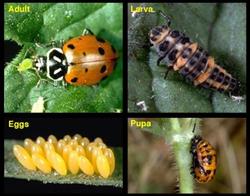 Lady beetles develop through four life stages: egg, larva, pupa, and adult by Jack Kelly Clark, UCANR
Lady beetles develop through four life stages: egg, larva, pupa, and adult by Jack Kelly Clark, UCANRFor more information: Aphid Eaters
- March, April, May, June, July, August -
Sheet Mulching - "Lose the Lawn"
-
An easy and environmentally friendly way to "lose the lawn" is to smother the grass and mulch at the same time. Place cardboard or several layers of newspaper over the area, overlapping by eight inches to keep weeds from finding openings. Wet the cardboard or newspaper, then cover it with 4-6 inches of compost, plant trimmings, or other mulch. Having wood chips on top will give it a neat appearance. The materials will gradually break down and improve the soil over time. New plants can be installed by cutting an X in the cardboard or newspaper and placing the plants right through the mulch. UC Davis Arboretum Horticulturist Stacey Parker's website shows you how it's done.
- March -
Empty Standing Water
- Make sure you don’t have any water sitting around from our late rains. Mosquitos breed in standing water and can pass along deadly West Nile Virus to people. Check and dump water from any buckets, pots, saucers, dishes, or wheelbarrows. Put containers away or turn them over to avoid collecting additional water. Keep chemicals balanced in swimming pools. Ponds, fountains, and bird baths can also be breeding grounds. Add mosquitofish to these bodies of water to eat mosquito larvae. They are an environmentally friendly means of control and are available free of charge from Santa Clara County Vector Control.
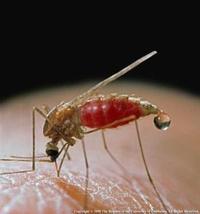
More information: Empty Standing Water Video
- March, April, May -
Yellow Leaves on Citrus Trees
- While there are several possible causes for yellow citrus leaves, the most likely one in winter/early spring is that citrus roots do not absorb nitrogen efficiently from cold, wet soils. There may be adequate nitrogen in the soil, but the roots aren’t able to take it up. However, if the tree doesn’t green up when the weather warms, give it some nitrogen fertilizer, up to 1 lb of N per year for a mature, full-size tree. Dwarf trees or ones in containers require less fertilizer, 1/2 lb of N or less. Do not overfertilize since that may cause other problems.
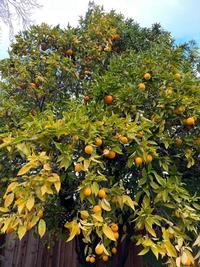
More information: Growing Great Citrus
- January, February, March, April -
Should You Prep Soil for Planting?
- It’s tempting to grab a shovel and turn over all the soil in your garden as you prepare for summer planting. But should you? Increasingly, science is saying “no.” Every time you dig into the soil, you’re disturbing a very intricate, living web of organisms, bacteria, and fungi that your plants need to thrive. In contrast, a “No-Till” approach minimizes soil disturbances and keeps organic material like leaves, compost and coarsely chopped plants on the ground’s surface to slowly decompose. By keeping it moist and protected from beating sun and pounding rain, this organic material allows the soil to stay crumbly and ideal for planting.
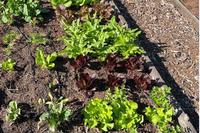
More information: No-Till for Home Gardeners
- March, April, May, October, November -
Broccoli - Multiple Harvests
- Did you know that most broccoli plants can give you multiple harvests? The first central head that they produce will be the largest and fullest. But after you harvest that one, the plant will start to produce lots of smaller heads, called side shoots. They sprout from buds in the leaf axils, where the leaves join the stem of the plant. You can keep harvesting these tender shoots, sometimes called broccolini or baby broccoli, for another 2 to 3 months.
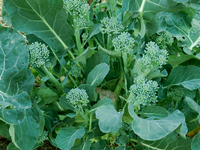
More Information: Growing Broccoli
- March, April, May, June, September, October, November, December -
Leafy Salad Plants
- Harvest your leafy vegetables early and often. Many leafy vegetables will bolt (go to flower) quickly if not harvested. When you harvest lettuce or similar greens, remove only the outer, older leaves. New leaves will continue to grow from the center, and you'll be able to eat salads all winter. Harvest head lettuce all at once when the head is full and firm. Watch for signs that plants are getting ready to bolt. That’s the signal it’s time to harvest the entire plant.
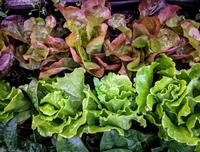 More Information: Growing lettuce in Santa Clara County- January, February, March, November, December
More Information: Growing lettuce in Santa Clara County- January, February, March, November, December -
Shovel Pruning
- Sometimes a plant just isn’t working out in your garden and it comes time to part ways. The most drastic form of pruning is “shovel pruning” where you finally just dig the plant out. Another term for this technique is “editing the garden.” Perhaps you saw a plant you liked in another part of the country or world. If that other location had a different climate or soil type, it may not translate well to sunny, dry California with our clay soils. Perhaps you want to garden organically but the plant has too many pests or diseases and you are having trouble controlling them with organic methods. Or maybe it simply doesn’t resemble what the tag promised. It’s okay to let go. Spring and Fall are good times for new plantings, so it is also a good time to reassess the appropriateness of what’s in your yard.- March, September
-
Raised Beds
- Raised beds make gardening easier in several ways. You don’t have to bend over as far to reach the surface. You can add any soil blend you like and you won’t compact the soil around the roots by walking on it. You can also better protect the roots and plants from critters. You can build them with wood or cinder blocks or anything that doesn’t have chemicals that can leach out into your food, for example, no pressure-treated lumber or railroad ties with creosote. If you’re using wood, redwood and cedar are the most resistant to pests and rot. You can be particularly green by using old fence boards or decking. Locate the beds where the plants will get the sun they need. Make sure the width is not more than twice your arm length so that you can easily reach all parts from the sides. To prevent gophers and other pests from tunneling into the root area, line the bottom of the bed with hardware cloth.More Information:
- Gardening in Raised Beds (Page 7)
- Raised Beds in Vegetable Gardening Basics
- Quick and Easy Raised Bed Design
- March, April -
Transplanting Vegetables
- As vegetable seedlings start to outgrow their pots, you can transplant them into larger pots, raised beds, or the ground. Make sure the seedling is well-watered before moving it. To remove the plant, either turn the pot upside down — with your other hand positioned to catch it! — or pull the entire root ball out with a fork or other utensil. Be sure never to handle the seedling by the stem, with its vascular tissue that conducts water and food. If the roots are packed together or circling, gently pull them apart. Then gently move the plant to its new home, lightly packing the soil around it. Make sure the soil is at the same level on the stem as in its original pot, except for tomatoes and peppers which can be planted deep. Immediately water thoroughly. A little fertilizer can also be added when transplanting. Transplant shock can be minimized by not changing too many conditions at once, e.g., temperature, wind, or sun exposure.
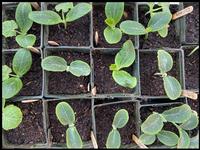 More information: Vegetable Planting Handbook (Los Angeles Master Gardeners)- February, March, April, May, June, July, August, September, October
More information: Vegetable Planting Handbook (Los Angeles Master Gardeners)- February, March, April, May, June, July, August, September, October -
Garden Planning in a Drought
- Even when we get good winter rains, our summers are dry. So, water-wise garden planning is always a smart choice. We can prioritize the plants with more value, including food production or a long-term investment. If your existing plants are crowded, consider removing some so they don’t compete for water. This is a great time to get rid of any that you don’t really like. Why waste water on them? Don’t add new plants to your landscaping while we remain in a severe drought. Even drought-tolerant plants and California natives need extra water to get established.
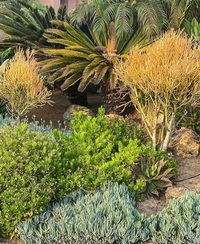
More information: Drought: Gardening Tips
- March, April, May, June -
Drought Tip - Irrigate Efficiently
- Water restrictions are being put into place all over the state due to the current drought. With over half of urban water used in landscapes, it is essential to make sure your irrigation system is efficient. Watch your plants for signs of underwatering, overwatering, or uneven watering. Consider reducing irrigation times. And make sure your water bill hasn’t unexpectedly jumped. Also, adjust systems on timers monthly as the weather changes or use an automatically-adjusting smart controller. A smart controller can make the needed adjustments after initial programming with plant, location, and other relevant information. Our Santa Clara County clay soil absorbs water slowly, so only water for a few minutes at a time to avoid runoff. Then repeat until the water penetrates to the depth of the roots. Inspect drip and sprinkler systems regularly to make sure there are no leaks, emitters are not clogged and it is watering the plants and not the sidewalk, also make sure the water is going to the root zones of the plants. If you run a hose to a plant, set a kitchen or cell phone timer so you don’t forget that the water is running. Valley Water can help residents with Water Wise Outdoor Surveys and Landscape Rebate Programs.
More information: Irrigation System Audit
- March, April, May, June, July, August, September, Any month -
Drought Tip - Lawns
- This landscaping feature—imported long ago from rainy, foggy England—does not translate well to a semi-desert with frequent droughts. Lawns demand a huge investment of water, money, time, work, equipment, and fertilizers and other chemicals. According to Scientific American, U.S. lawns require the equivalent of 200 gallons of drinking water per person per day. Many people are joining the "lose the lawn" movement, and UC Davis offers several plans and examples to help you get started on a yard design more appropriate for our climate. Valley Water offers rebates and guidance for lawn replacement. If your family uses your lawn and you want to maintain it this summer, follow the irrigation regulations of your local water company and aim for survival rather than a lush green carpet. A lawn that looks light green or brown will often be dormant (not dead) and will perk up with the winter rains; the roots can survive much longer than the blades above ground. Keep it mowed in the meantime so that weeds don’t go to seed and take over. Concrete and synthetic (plastic) turf do not benefit the environment other than not using much water.

More information: Drought Resources
- March, April, May, June, July, August, September, Any month -
Frost Dates
-
The approximate first and last frost dates for Santa Clara County, depending on your location, are November 15 and March 15. These are important dates for gardeners to remember.
First frost date—this is the earliest date you should expect frost to occur. If you have plants that need to be brought in for the winter, or crops you need to pick before frost, this date will be important to you.
Last frost date—after this date, you wouldn't expect any more frosts. It's generally used as a milestone when pruning frost-sensitive plants (such as citrus where you don't want to stimulate delicate new growth until the danger of frost is past).
For our climate, the last frost date is not a reliable metric for when to transplant summer vegetables. Daytime temperatures and soil temperatures are more important. See entries for individual vegetables for specific recommendations.
Also see: Frost—Avoidance and Dealing with Damage
- January, February, March, November, December -
New Trees Staking
- Not all new trees even need to be staked. Only stake if necessary for protection, anchorage, or support. Don't place the stakes too close to the trunk of the tree. Place stakes on opposite sides of the tree, outside the root ball. Make sure the stakes don’t rub on the trunk or branches. Ties should be added no higher than necessary to support the trunk. This allows as much freedom to move as possible, and movement builds trunk strength. Inspect the tree regularly to make sure there’s no damage. Remove the ties and stakes when the tree can stand on its own, generally after a year or so.
More Information: Tree Staking- January, February, March, April
-
Inspect Roots When Planting
- If you’re adding plants to your garden this spring, check the roots before putting them into the ground. Two things are particularly important. First, look for circling roots, which can eventually strangle the plant. Straighten them out as much as possible and consider pruning them if they’re too big to spread. Second, note where the roots start growing and plant at that depth, or slightly higher to allow for some settling. If planted too deeply, plant roots cannot get enough oxygen to grow and may suffocate and die. Planting too shallow can result in root damage from exposure and excessive drying.
More Information: Fix Those Roots Before You Plant
- February, March, April, May, September, October, November -
Time to Prune Frost Damage
- When there is still a danger of frost, we recommend leaving frost damage on plants so it provides protection to undamaged parts. Once the cold winter weather is behind us, it's time to prune frost-damaged plants. Pruning it off would stimulate tender growth that is susceptible to frost. Although the typical last frost date will vary depending on your location within the county and its microclimate, it’s time to start the spring cleanup soon.
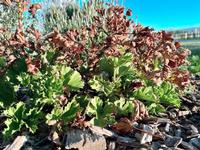 Frost damage on pelargonium
Frost damage on pelargoniumMore information: Treating Cold-Damaged Plants
- March, April -
Potting Mix vs Planting Mix
- Is there a difference between potting mix, potting soil, and planting mix? The best advice is to read the label. The terms for bagged mixes aren’t regulated, so they can vary by manufacturer. What’s important to know is that not all bagged mixes can be used in pots. Some are meant to be used as garden fill, amendment, or mulch, so they won’t provide the right water retention, drainage, or nutrients for container gardening.
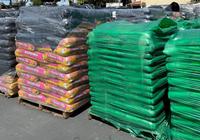
For more information: Bagged Potting Mixes
- March, April, May, November -
Weed Spotlight - Spotted Spurge
- This annual weed is native to the eastern US but is now common in home gardens here in California. Spotted spurge germinates at temperatures as low as 60ºF and is often found in open areas, sidewalk cracks, and thin lawns. It forms a dense mat of foliage that grows radially from a central taproot. Left unchecked, each plant can grow to 3' across and can produce thousands of seeds. The seeds need light to germinate, so a 2" cover of mulch usually provides effective control. Pull weeds when you see them, removing the root to prevent regrowth. Use gloves to avoid contact with the white sap which can irritate skin.
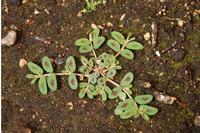 For more information: Spotted Spurge Management Guidelines- March, April, May, June, Any month
For more information: Spotted Spurge Management Guidelines- March, April, May, June, Any month -
Why You Should Test Your Soil
-
Before adding fertilizer or soil amendments to your garden, first find out what your soil really needs by conducting a soil test. Knowing your soil’s pH value is important in determining which plants will thrive or struggle in your soil. Understanding the levels of nitrogen, phosphorous, and potassium in your soil will tell you which nutrients are abundant and which are lacking. Don’t overfertilize – excess nutrients can pollute local waterways. Commercial soil testing labs provide the most thorough results, but several home kits can give you a good baseline. Test soon and be ready for spring planting.
- January, February, March -
Bolting Lettuces
- In garden terms, bolting means sending up a flower stalk, not desirable unless you plan to save seeds. Seed packets say lettuce matures in 60–80 days, but the timing also depends on the weather. In warm weather, lettuce matures and bolts much faster. In cool temperatures, seedlings grow more slowly but will still mature and bolt eventually. If the center of the lettuce starts to push upwards, that’s a clue that it’s starting to bolt. Another clue is if you tear a leaf and see milky sap instead of clear juices. Harvest as soon as you notice, before the leaves become unpleasantly bitter.
More information: Growing Lettuce
- January, February, March, November, December -
Irrigation Maintenance
- Check your watering system regularly to make sure it’s working properly. Sprinklers and emitters that are plugged up or misdirected can cause problems for the plants they’re supposed to water, and broken emitters and hoses waste water. Get ready for the growing season by starting a watering cycle for each zone of your controller and visually checking its operation. If you’d like help, Valley Water offers a free evaluation service for properties less than ½-acre in size. Use the link below to schedule a survey. - March, April, September, October
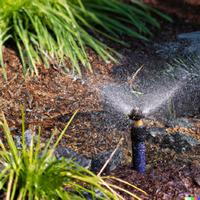
-
Protect Native Bees
- You probably see non-native honeybees in your garden, but do you know there are over 1600 species of native bees in California? These bees don’t make honey, don’t live in hives (most live right in the ground), and are much less likely to sting since they have no colonies to defend. Research shows some species pollinate crops twice as effectively as honeybees, plus they’re best suited to pollinate native plants. But like honeybees, they’re threatened by pesticides and loss of habitat. Help preserve these species by growing a variety of plants that flower at different times of the year and by keeping areas of open ground in your yard.
More information: Native Bees and Their Favorite Plants
Native Bee images, clockwise from top left: Leafcutter bee (Jim McCulloch), carpenter bee (Kathy Keatley Garvey), long-horned bee (Kathy Keatley Garvey), sweat bee (Missouri Department of Conservation Staff)
- March, April, May, June, July, August -
Planting Trees or Shrubs
- You may be tempted to amend the soil when planting trees or shrubs, but it’s no longer recommended. If the soil in the hole is amended, it creates soil moisture differences that discourage the roots from growing into the native soil beyond the hole. For best results, dig a hole about twice as wide as the container. Rough up the sides to help the roots penetrate. Don’t loosen the soil in the bottom of the hole or the plant may settle too low. The goal is to keep the crown of the plant slightly above the surrounding soil. Then simply backfill with the native soil from the hole.
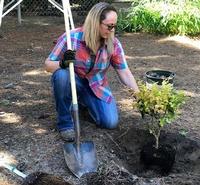
More information: Planting for Success
- March, April, May, September, October, November -
Burning & Stinging Nettles
- Our gardens are pleasant places but not if you find burning nettle (Urtica urens) or stinging nettle (Urtica dioica) among your flowers or vegetables. You’ll know they are there if you brush against them and immediately feel a burning or stinging sensation. Leaves and stems are covered with hair-like tubes that inject an irritating substance when touched. Look for them in late fall and early spring. Remove them as soon as they appear, using gloves for protection. They can produce viable seeds in just five weeks and produce 1,500 seeds per plant. A thick layer of mulch or cover crops with dense canopies can help suppress germination.
More information: Burning & Stinging Nettles
- March, April, October, November -
Support Your Vegetables
- Save garden space by providing good support systems for climbing or vining vegetables like tomatoes, pole beans, and cucumbers. Growing vertically also keeps plants healthier by improving air circulation, increasing sun exposure, and keeping fruits off the ground. Even shorter plants like peppers and eggplants benefit from support since heavy fruits can cause unsupported branches to break. There are many possible choices, from commercial cages and stakes to creative reuse solutions. It’s best to install the supports at planting time to avoid damaging the roots or breaking the stems of your new plants.
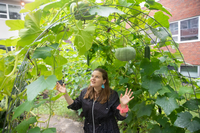
More Information: Trellising, Staking, and Caging
- February, March, April, May, June -
Flowering Vines
- Vines are plants that climb or sprawl and can easily outgrow their spaces if not pruned annually or more often. Many are pruned in the winter when they are dormant. This reduces shock to the plant and allows you to better see the structure when pruning. If the vines are flowering, wait until after the blooms have finished. Some vines get cut back almost to the ground to renew them. Some are cut back to the beginning of the herbaceous growth, leaving the woody vines. Others are pruned simply for shape or size. The UC Davis Arboretum All-Stars brochure includes several flowering vines. All-Stars are plants that have been tested and proven to thrive in California. The brochure lists pruning needs. It also has photos, characteristics, and requirements of the plants if you are looking for new plants.
More Information: Marin Master Gardeners: Vines- January, February, March
-
Certified Arborists
- Whether you prune your own trees or hire someone, it’s important that whoever does the job knows at least a little about tree anatomy, plant health, and the purpose of the plant (shade? privacy? fruit?). Knowing the difference between heading cuts and thinning cuts, how to locate a node to direct growth, and how to open up a tree for air circulation are all part of good tree pruning. An improper pruning job can stress the tree, spread disease, invite pests, and promote weak branching. These can lead to breakage, damage, and injury. The cheapest bid may end up costing more in the long run due to damage repair, lawsuits, and additional fix-it pruning. Take a class or read tree pruning guides if you want to do a good job yourself. If you hire someone, it is strongly recommended that you choose a certified arborist who has been specially trained and is insured. The International Society of Arboriculture can help you find a certified arborist in your area.More Information: Tree Pruning Guide- January, February, March, December
-
Stinkhorn Mushroom
- You might find stinkhorn mushrooms growing out of a lawn or a pile of mulch. They come in many colors, shapes, and sizes. They can grow as fast as four to six inches per hour. Stinkhorns get their name from their foul odor, described by some people as a rotting meat smell. The smell attracts insects, which then spread the mushroom spores. While the smell is unappealing, stinkhorns are short-lived, and they help break down organic matter into the soil. They are most likely to appear in cool, wet weather. UC has management advice for mushrooms and other nuisance fungi in lawns.
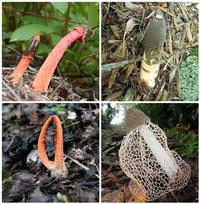 Clockwise from upper left: Tom Volk, Ted Geibel, Troy Bartlett, and Gloria Schoenholtz. From the University of Wisconsin-Madison Division of Extension
Clockwise from upper left: Tom Volk, Ted Geibel, Troy Bartlett, and Gloria Schoenholtz. From the University of Wisconsin-Madison Division of ExtensionMore information: Stinkhorn Mushroom
- January, February, March, October, November, December -
Weed Spotlight - Bindweed
- Have you seen a pretty, morning glory-like flower on a vine that winds through any plant within reach? Field bindweed is one of the most challenging weeds to control because its roots can reach depths of 20 feet or more and it readily re-grows from root fragments as short as 2 inches. The only chance of controlling this invasive weed is to stay right on top of it and remove it as soon as you see any of it peeking up out of the ground. Every time it starts growing above ground and photosynthesizing, it is storing energy in the roots. This allows it to put out new shoots. It produces many seeds which remain viable for years. Making things even worse, it’s drought tolerant. Controlling it isn’t easy, but the UC pest note below discusses options. Chemicals aren’t needed if you’re persistent in removing new growth to prevent seed production and limit the plant’s ability to store new energy in the roots.
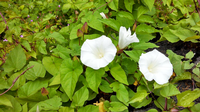
For more information: Field Bindweed Pest Notes
- March, April, May, June, July, August, September, Any month
2. What to plant
-
Fresh Cut Flowers from Your Garden
- We have a webpage to help you choose and grow beautiful cut flowers for your home or to give away. The Cut Flower Planting Chart lists ornamentals we’ve grown successfully. We selected these for their hardiness, appeal to pollinators, and production of good cutting flowers. The chart tells you when to start these flowers from seeds or when to transplant, plus when you can expect to see blossoms.
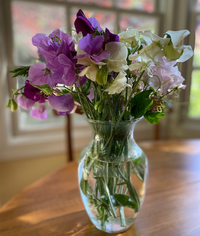
More information: Tips on planting a cut flower garden
- January, February, March, April, May, June, Any month -
Plant Cool Season Vegetables again
- Salad greens, carrots, beets, fennel, broccoli, and bok choy are just a few of the vegetables that you can plant now. The warming weather and longer days will help them mature quickly. By the time they’re done, it will be warm enough to plant summer vegetables like tomatoes and peppers. You can direct seed into the garden or get a head start by transplanting seedlings. Use our vegetable planting chart for a full list of suggestions. - February, March, April
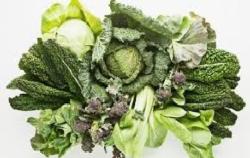
-
Lawn Alternatives
- Do you have a traditional lawn? Would you like something that doesn’t need regular mowing? Something that uses less water? If you’re not ready to completely remove your lawn, walkable alternatives include California native options of red fescue and meadow sedge, as well as other alternatives like white clover, UC Verde buffalograss, Kurapia, Dymondia, and thyme.
For more information: Lawn & Lawn Alternatives
- March, April, May -
Stone Fruit Hybrids
- Plant hybridization is the crossbreeding of different plant varieties. It can happen naturally but more often comes from deliberate work. A goal of hybridization is creating a new plant with the most desirable traits of its parents, such as the sweetness of a peach and the tartness of a plum. There are many different types of stone fruit hybrids. Here are some examples:
- Pluot and aprium: hybrids of a plum and an apricot, named for which fruit dominates.
- Plumcot: a 50–50 hybrid of a plum and an apricot.
- Peacotum: a hybrid of peach, apricot, and plum.
- Nectaplum: a hybrid of a nectarine and a plum.
- Cherum: a hybrid of a cherry and a plum.
- Peacherine and pectarine: hybrids of a peach and a nectarine.
- Nectarcot: a hybrid of a nectarine and an apricot.
These hybrids have had varying degrees of commercial success, and availability may be limited. But development continues, so you may hear of others in the future.More Information: Demystifying Stone Fruit Hybrids- March, April, May, June -
Selecting Seeds
- While curled up inside the warm, dry house poring through seed catalogs, how do you decide among all the delightful descriptions? First, be clear on the purpose of your garden. Are you trying to grow exotic food? Do you want to attract native butterflies? Are you interested in flowers you can cut and bring inside? Next, think about the conditions of your site. Is it warm and sunny or is there a lot of shade? Do you have heavy clay soil? Choosing seeds that do well in your area makes for healthier plants with less work. At this point, you have the parameters within which to choose what tickles your fancy. If you would like to save seeds in the future, then choose open-pollinated seeds, including heirlooms. Heirlooms are open-pollinated seeds that have been around for multiple generations. Otherwise, you can plant hybrids that have the best traits of their parent plants but will not reproduce true to type from saved seeds. Follow planting directions on the packet for the best results.
More Information: Seed Saving- January, February, March, May, June, July, August, October
-
Thyme
- Thyme is much more than an herb to season food. In ancient times it was brewed by Egyptians for mummification, bathed in by Greek soldiers for courage in battle, and used by the Sumerians as an antiseptic and antifungal. And if you want a real surprise, check out the active ingredient list on a bottle of Listerine mouthwash. In your own garden it can be used for culinary purposes or as a purely ornamental landscape feature. It grows best in well-drained soil and sunshine, although it will tolerate some shade. It is quite drought tolerant once established. Common/garden thyme (Thymus vulgaris) is an excellent all-purpose thyme, growing to a foot tall and up to two feet wide. Lemon thyme (Thymus citriodorus), with its lemon scent, makes a nice evergreen border. Creeping thyme (Thymus serpyllum) stays short and can be used as a ground cover or between stepping stones. Thyme is attractive to butterflies and bees.More Information: Growing and Using Thyme- March, April, May, June, July
-
Peas
- An old American tradition says that planting peas on St. Patrick’s Day will bring good luck at harvest time. But the best planting date actually depends on the climate where you live. Planting on St. Patrick’s Day in the northeast may lead to a second planting weeks later when frost gets the first batch. Yet in warmer climates like ours, we can plant weeks earlier and may even be eating peas from the garden on St. Patrick’s Day. (We can also plant them here in the fall.) You may want to soak the seeds overnight to help get them ready to germinate. They can be planted directly in the ground, about half an inch deep. Keep the seeds evenly moist until they start to sprout. Provide a trellis or some kind of support for the vertical vines if you are growing pole peas; bush peas can stand on their own.
More Information: Peas- February, March, August, September
-
Sweet Peas
- You have probably heard people use the "sweet peas" term incorrectly. In garden terminology, sweet peas are flowers. They are not edible and are poisonous. Edible peas, even if sweet in taste, are not correctly called sweet peas. Sweet peas are incredibly fragrant vining flowers that come in a variety of colors, mostly pastels. They are an annual flower so they must be planted again every year. You can sow seeds anytime during the winter for spring bloom. The seeds are hard and it can be helpful to nick them slightly before putting them in the ground. Sweet peas do best in full sun or light shade. The plants will decline when it gets hot outside and they will need to be removed. Remember, you cannot eat sweet peas.- February, March
-
When to Start Summer Vegetables from Seed
- If you start your seedlings too soon, they can get leggy and overgrown before it’s time to plant them. Tomatoes reach transplant size in 6 weeks, peppers take 8–10 weeks, and cucumbers take just 4 weeks. Plan when you want to transplant into the garden, then calculate backward to figure out when to start seeds. Our vegetable planting chart recommends transplanting tomatoes in May, so start seeds 6–8 weeks before, in March to early April. The hottest varieties of peppers need a long growing season for the pods to ripen. Start peppers earlier, mid-February to mid-March. Wait until May to start heat lovers like cucumbers and melons.
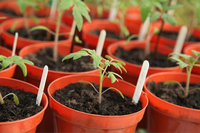
More Information: Growing Transplants from Seed
- February, March, April -
Herbs
- Many herbs can be grown both indoors and out, in pots or in the ground. Rosemary grows large and needs to be in the ground or a big pot. If you use basil to make pesto, you may want a row of it in the garden. Yet most herbs tend to be used in small quantities for seasoning and so they can be grown in small containers. They can be on the kitchen counter or a windowsill for ease of use in cooking. They can be on a patio if you are in an apartment or condo. And they are well suited to container gardening outdoors. Woody herbs can be grown from cuttings, lemongrass can be started from stalks from the store, and most others can be started from seed. After harvesting, many can be dried as well as used fresh.More Information: Growing Herbs- March, April, May, September, October
-
Seed Viability
- Seed packets have a “packed for” date on the back. Yet seeds can still be viable for years beyond that date if stored correctly. Ideal storage conditions are cool and dry. The older the seeds are, the lower the germination rate will be. So plant more of the older seeds than the number of plants you ultimately want. You can do a germination test by putting seeds on a damp paper towel and enclosing them in plastic to keep them uniformly moist. Do this right before planting time so you can transplant the ones that successfully germinate. Or you can take your chances and just plant them directly and see what comes up. If you are saving your own seeds, make sure to choose seeds from the healthiest plants.
Whenever it's hard to find flower seedlings, if you have some old flower seed packets, you can scatter the seeds randomly in a section of your yard and enjoy whatever flowers.
More Information: Vegetable Seed Viability- January, February, March, April, May, August, September, October -
Camellias
- Camellias can be planted in fall through spring. Since they bloom in winter, choosing a plant now will ensure that you know the color, shape, and size of the flowers with which you will live for many years. Camellias are not native to our area so may need some extra attention in order to grow successfully. Our native clay soil does not drain well so it must be amended for camellias. Our alkaline soil needs to be acidified, and sulfur pellets are one way to achieve this. The plants need some shade and need to be kept moist. Mulch helps hold in moisture, and pine needles, redwood bark, and coffee grounds are all good organic materials that will break down over time and help improve the soil. Pick up flowers as soon as they fall to the ground to avoid the spreading of a disease called Camellia petal blight.
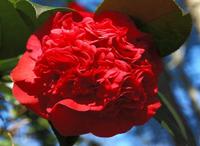
More information: Camellia Pests
- January, February, March, April, May, September, October, November, December -
California Natives
- Thinking of adding native California plants to your yard? New natives respond best to wet winter weather, which promotes the extensive root development needed for spring growth and the hot dry summer months ahead. Your next question may be what to plant. That depends on your planting site and the individual cultural requirements of the plant. To help, the California Native Plant Society has created a database where you can enter your address and find which plants do best in your neighborhood for the conditions in your yard, like sun or shade. The website even lists nurseries that carry California natives.
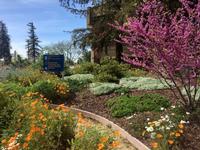 More Information:- January, February, March, December
More Information:- January, February, March, December -
Chayote
- This mild, green, pear-shaped squash grows on a vine that can produce prolifically for several years. Although it is often recommended to plant it in the spring, some cultures traditionally plant it on Día de la Candelaria, February 2. The seed inside is very soft, so the way to start a new plant is from a whole chayote. Leave the chayote on the counter for a new vine to sprout from the seed within. Then plant it in the ground at a 45-degree angle with the large end pointing downward. The roots will grow from the same end as the shoot. It does best in a sunny location with well-drained soil. Provide strong vertical support from the start because the vine will grow very tall.
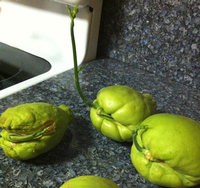 More information: How to grow chayote video- February, March, April
More information: How to grow chayote video- February, March, April -
Growing Purple Carrots
- If you only buy carrots at the supermarket, you may think that they are all orange. It is believed that carrots were originally purple, with orange becoming popular through Dutch breeding. Several colors are now available at Farmers’ Markets and by growing your own. Springtime is a good time to start carrots from seed. Transplanting is not advised because you can easily damage the roots which are the relevant plant part. Loose soil is important so that the carrots will grow straight. Scatter the seeds over the soil with as thin a covering as possible, keep moist until germination, and harvest when the tops expand to a good size. The Master Gardeners have done germination and growing experiments with different varieties and soil blends. Covering seeds with a thin layer of vermiculite yielded the fastest and highest rate of germination. Carrots are slow to germinate and could take as long as 3 weeks. Thin to 2 or 3 inches apart. For growing, a soil blend of 1/3 compost and 2/3 soil produced higher-weight carrots than blends with half of the soil replaced with either sand or perlite.
Some common problems are twisted roots from planting too close together, forked or deformed roots from clods and rocks in the soil, a hairy root from too much nitrogen and splitting from too much water.
More Information: Growing Carrots
- February, March, April, September -
Bare Root Plants
- Bare root plants are sold without any soil clinging to the roots making them easier and less expensive to transport; they'll do just fine in the garden as long as you don't let them dry out before planting. Because you can see the roots and can control how they're placed in the soil, it helps reduce the chances of root girdling problems later. Buy and plant early in the month while roots are still fresh.
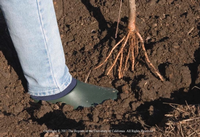
The bare roots should be soaked from an hour to overnight (large plants) in a bucket of water before planting. Trim roots of broken, dead, or spongy bits and carefully pull the roots apart. Dig a hole that is fairly shallow and wide. Spread the roots out sideways and have the crown of the plant several inches above the soil level. This is necessary as the plant will settle down over time. Water in well but wait to fertilize until you see new shoots growing. Be sure to water regularly if the rains are sparse. Staking may not be necessary.
Trees aren't the only plants that are sold bare root. You can also plant bare-root asparagus, artichokes, rhubarb, berries, kiwifruit, horseradish, rhubarb, grapes, roses, strawberries, and iris in January.
More information: Planting Bare-Root Fruit Trees
- January, February, March -
Plant Asparagus Crowns
-
Asparagus crowns can be planted now. Dig a trench eight to twelve inches deep, mix in fertilizer at the bottom and cover with two inches of soil. Set the roots in the trench about 18 inches apart, and cover with two inches of soil. Gradually fill in the trench as the plants start to grow. Asparagus is a perennial vegetable that will produce for several years. It's best to wait until the second year to harvest to let a strong root system develop for long term production. For more information, read UC Davis' Growing Asparagus in the Garden.
- January, February, March -
Plant Garlic & Shallots
- The time to plant most garlic and shallots is mid-October through the end of November. Fast-growing Dutch Red shallots can mature in just 90 days, so can be planted again in late winter or early spring. Specialty growers guarantee disease-free stock and offer many more garlic varieties than you see at the grocery store, from beefy Chopaka Mountain to beautiful Rose de Lautrec.
Choose the largest cloves and leave the natural papery wrappers on them. Plant them in moist, well-drained soil in a sunny location with the pointy tips up, about one inch deep. Space cloves about four inches apart to leave room for large heads to develop.
More information: How to Grow Garlic | How to Grow Shallots
- February, March, October, November -
Asian Vegetables
- You can easily grow some vegetables used in different types of Asian cuisine and found in Asian markets. They are not necessarily native to Asia but have found their way into various cuisines. One way to decide which food to grow yourself is to choose varieties that aren't readily available or are more expensive in your local markets. It’s also fun to impress your family, friends, and neighbors with something they may not have seen growing before. Possibilities include sesame seeds, bitter melon, opo, sigua (loofah) in summer and bok choy, napa cabbage, daikon radishes, gai choy in spring or winter.- February, March, April, May, June, September, October
-
Attracting Bees
-
Bees are pollination workhorses, increasing garden production. Many plants will not produce fruit unless flowers are pollinated. Colorful annuals, such as Cosmos, edible African Blue Basil, and Salvias attract bees. You can also allow herbs and other plants to flower to create bee-friendly landscapes.
The University of California at Davis has a garden dedicated to bees. The Honey Bee Haven website has more resources, including a list of plants they grow.
- March, April, May, June, September, October -
Growing Transplants from Seeds
- Many summer vegetables can be started now from seed indoors or in a greenhouse. The ground is still too cold for summer seeds to germinate or for the plants to go into the ground. Depending on the weather we get this spring, it will likely be May or June before the soil is warm enough. The soil in containers or raised beds will warm up earlier in the season.
Starting plants in pots will give them time to get stronger before putting them near potential pests. It will also allow you to continue enjoying current cool-season vegetables.
Information found on the seed packages will show which conditions are best for germination. Peppers in particular germinate best with high soil temperature. Using a heating pad is one way that this can be done indoors.
Be sure to provide light once the seeds germinate if the seedlings are not in natural sunlight. Seedlings with insufficient light will grow tall and thin and leggy and will not be as strong.
When reusing pots for seed starting, prevent the spread of plant diseases by making sure they are clean. Remove any remaining soil and cobwebs; then clean with a 10% bleach solution: 1 part bleach to 9 parts water.
If they are growing too large for the pots they are in, transplant them into larger pots. The same can be done for seedlings purchased from a nursery. Transplant them on the ground as suggested under "when to plant" for each vegetable tomatoes, peppers, cucumbers, squash, and melons.
This video provides more details on raising your own seedlings.
- February, March, April -
Vegetable Planting Chart
-
Wondering what vegetables can be planted now? To get the best success—whether planting from seed or transplants—refer to our Santa Clara County Vegetable Planting Chart. It's based on our own garden experiences.
- February, March, May, June, July, August, October, Any month -
Flowers To Attract Beneficial Insects
-
Certain flowers help attract natural enemies of pest insects in the garden. Tiny wasps that parasitize certain insect pests or their eggs need pollen and nectar to survive. Predatory insects (syrphid fly larvae, lady beetles, lace wings, and many others) and mites survive on pollen and nectar from flowers when pest populations are low, and some feed on pollen in order to reproduce.
Most of these beneficial insects are small, and so the best flowering plants to include in the garden are those that have small flowers that have pollen and nectar easily accessible and that bloom throughout the season. Avoid flowers that are difficult to weed out when they reseed.
Many flowers that attract beneficial insects are easy to start from seed and this month is a good time to start them – some indoors any time or outdoors later in the month after frost danger has passed. Examples include sunflowers (try dwarf varieties like ‘Sunspot’ for smaller spaces), calendula, cosmos and many herbs like dill, basil and borage.
Other flowers and herbs that attract beneficial insects are easier to buy as plants. A few examples that can be planted this month are coreopsis, asters, and thyme.
Reference info:
- March
UC Pest Note on Biological Control and Natural Enemies of Invertebrates
UCCE notes on Attracting Beneficial Insects to Your Garden. -
Plants to Attract Butterflies
-
Butterfly populations fluctuate in response to climate and habitat conditions. Many have specific host plants on which they feed and breed. Some common plants for attracting butterflies are milkweed, lantana, buddleia, and zinnias. For an extensive list of relationships between specific butterflies and host plants, see Art Shapiro's Butterfly Site at UC Davis.
- March, April, May, June
3. Pests and Diseases
-
Citrus Pruning and Care
- Once the threat of frost is past (typically March 15), it's a good time to cut back branches that touch the ground, fences, or other structures. Thin the tree to let more air into the middle. Trim out crossing branches and anything that looks dead.
Pruning is not needed for fruit productivity yet may be desired for size management. Pruning will also help control scale and aphid infestations. If you see ants in the tree, use a sticky goo (such as Tanglefoot) on the trunk to keep them out of the tree. Be sure to apply the goo on top of tape rather than directly on the trunk. The ants 'protect' the scale and aphids. If you see scale (bumps on bark), thoroughly spray with horticultural oil to suffocate them.
Yellowing of leaves is normal this time of year as the iron that keeps the leaves green is chemically unavailable because the soil is too cold. When the soil warms up (over 60° F), check for yellowing. You may not need to apply a nitrogen fertilizer if the new leaves are green.
Refer to the UC Home Orchard web site for more Citrus Care information.
- March -
Rat Management
- Have you found a hollowed-out orange or other sour fruit like Meyer lemons with no skins, tomatoes with bite marks, fruit with holes gnawed in them, or grape skins or cherry tomato skins scattered around? It is the work of a roof rat.

Rats show up when your citrus, tomato, or fruit first starts to ripen. Rats are agile climbers and usually live and nest in shrubs, trees, and dense ground cover like ivy. One management strategy is to prevent access to the tree by cutting branches away from fences or other trees, leaving a gap of at least 2–3 feet, good sanitation is required. Garbage and garden debris should be eliminated. Use tight-fitting lids on garbage cans. Thin out dense vegetation to make the habitat less desirable. Mow ivy once a year to the ground. Climbing ivies on fences or buildings should be removed.
Per the UC pest note (linked below), trapping is the safest and easiest method for controlling rats. Read the pest note for other management strategies as well.
More information: Rat Management
- January, February, March, April, July, August, September, Any month -
Snails and Slugs
- Escargot may sound good on a plate, which is where the French who brought this delicacy to California in the 1850s intended for the ingredients to stay, but they escaped into gardens where they became pests. Brown garden snails are the most common ones we see (or don’t see) eating our plants. Signs of their presence include holes in fruit rinds and leaves, not necessarily at the edges, and slime trails. They tend to hide in dark damp places during the day and come out mostly at night. The best times to find them are at night with a flashlight, early in the morning, or during and right after heavy rain. They can be hand-picked and crushed or put in a bucket of soapy water. Gloves are recommended, especially with the shell-less slugs. Creating hiding places, such as laying a wooden board over a section of the garden, will draw them to that location so you can find and dispatch them in the morning. Copper barriers and beer traps are other options. If you do use snail bait, those made with iron phosphate are not toxic to pets and wildlife.
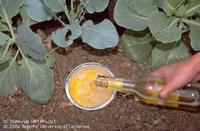
More information: Snails and Slugs
- January, February, March, April, December -
Camellia Petal Blight
- Camellias are beautiful except when the flowers turn a blotchy brown. This petal blight is caused by a fungus that continues to live in the soil once a plant is infected. To reduce outbreaks, pick off all infected flowers and dispose of them in green waste. Home composting is not hot enough to destroy the pathogen. After blooming, pick up any petal debris. Then spread fresh mulch around and beyond the bush (but keep the mulch a few inches away from the trunk).
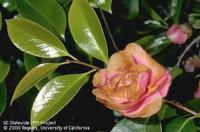
More information: Camellias Petal Blight
- March -
Brown Rot on Apricot and Peaches
-
- March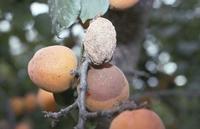 If your apricots or peaches had brown flesh last year, especially in the part surrounding the pit, they were probably infected with brown rot. It's a common fungal disease of stone fruit. You can spray with a copper spray at pink bud stage. A more important means of control is to remove affected fruit as soon as you notice it. The UC Pest Note on Brown Rot has more information.
If your apricots or peaches had brown flesh last year, especially in the part surrounding the pit, they were probably infected with brown rot. It's a common fungal disease of stone fruit. You can spray with a copper spray at pink bud stage. A more important means of control is to remove affected fruit as soon as you notice it. The UC Pest Note on Brown Rot has more information. -
Citrus Leaf Drop
-
Leaf drop from citrus trees is normal. Washington Navel oranges may lose over 3,000 leaves a day during peak leaf drop in the spring. Valencia oranges may lose about 1500 a day. Problems that can cause excessive leaf drop beyond these numbers are lack of water and a heavy infestation of spider mites. The tree's leaves will have brown spots if affected by the mites. You can wash them off with a strong water spray. Bud and small fruit drop is also normal. For further information see UC Pest Note on Diseases and Disorders of Citrus Leaves and Twigs.
- March, April -
Peach Leaf Curl Preventive Care
- Have your peach or nectarine leaves ever looked like this? These puckered leaves are a classic springtime symptom of peach leaf curl. Severe cases can substantially reduce fruit production. Prevent this disease by applying a copper-based fungicide shortly after the leaves drop. Use a second application in late winter if there’s a lot of winter rain. Once the blossoms open and leaves appear, it’s too late to do anything. Spraying during the growing season won’t help. If you haven’t seen this on your tree, you may have a resistant variety. If so, there’s no need to spray.
More information: Pear Leaf Curl
- March, April, May -
Brown Marmorated Stink Bug
- Native to Eastern Asia, this pest was introduced to the United States in the 1990s and has been established in Santa Clara County. Some features to distinguish these bugs from other stink bugs are white stripes on the antennae, a blunt head shape, and smooth shoulder margins.
They feed and reproduce on a variety of plants and are particularly damaging to fruit. You can cut cosmetic damage off fruit and still eat the rest of the fruit. To keep out stink bugs, cover vegetable plants with row covers. You can pick the bugs off plants and squish them or knock them off into soapy water. They are attracted to light and can get into homes where if vacuumed up, they can stink up your vacuum bag.
More Information: Brown Marmorated Stick Bug Pest Note- March, April, May, June, July, August, September -
Dormant Oil Spraying
- Deciduous fruit trees lose their leaves seasonally, usually in the autumn. They enter a period of dormancy when they are not actively growing and there is little activity within the plant. This is the time to apply dormant oil sprays to smother soft-bodied insects such as scale, aphids, and mites. First, do any needed pruning so that you will not be spraying branches that will soon be removed. Then inspect for pests that are overwintering on the trees, or remember pest and disease problems you noticed during the growing season. Although dormant oils may count as organic, it is still best to use them only if pest problems have been observed.
Mix the horticultural oil in a sprayer and apply it according to directions on the packaging. Never use more than what is prescribed. Make sure to complete the spraying before the trees start to bud and blossom so as not to damage developing flowers and fruit.More Information: Calendar of Backyard Gardening Operations for Selected Fruit and Nut Trees and Dormant Spraying of Fruit Trees- January, February, March
-
Citrus Leafminer
- What causes young, healthy citrus leaves to become gnarled and disfigured and what can be done about it? This damage is due to the citrus leafminer moth that lays eggs on new citrus leaves. Its larvae burrow into the leaf and leave tunnels as they feed, visible as meandering serpentine mines. Our advice: don’t worry about it. Leafminers can slow the growth of young trees but even heavily damaged trees are unlikely to die. Leafminers only attack young leaves — the tough leaves of mature plants resist infestation and fruit is not affected. Damaged leaves still produce food for the tree, so don’t cut them off. If you do, it will stimulate the tree to produce more new leaves — which will attract more leafminers!
More information: Citrus Leafminer
- January, February, March, April, May, September, October, November, December -
Slime Molds
- Slime molds come in a variety of colors and shapes. They often appear suddenly and look worrisome. They are fungi and need moisture to grow. According to the Mississippi State Extension, “when slime molds find something to eat, they surround their food and then swallow it. Slime molds may feed indirectly on dissolved substances escaping from organic matter, but they usually feed on microorganisms such as bacteria.” In general, no action is needed. When the area dries out, the slime mold will disappear. Just enjoy this marvel of nature while it’s there.
- January, February, March, April, October, November, December -
Identifying Beneficial Insects
- A whole army of insects is in your garden ready to help your plants thrive. Pollinators, like bees and butterflies, help plants produce fruit. Lady beetles and lacewings are predators that hunt, kill, and eat insects. And parasites, like certain wasps, develop within a pest’s body and then kill them. Such violence! The trick is knowing which insects are friends or foes. To identify the insects on your own, take pictures of them and any eggs or larvae (check the undersides of leaves). Then zoom in for a closer view and use this site to help you identify beneficial insects.
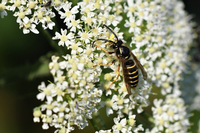
More information: Beneficial Insects
- March, April, May, June, July, August, September -
White Butterflies and Green Caterpillars
- Have you seen these small yellowish-white butterflies fluttering around? Cabbage white butterflies feed on many flowers, but for laying their eggs. They favor the cabbage family, such as broccoli, cauliflower, and mustard. The velvety green caterpillars, also called imported cabbageworms, feed on the leaves after hatching. While mature plants tolerate a few holes munched in their leaves, young seedlings don't have foliage to spare. Cultural controls include handpicking the caterpillars, brushing the eggs off the undersides of leaves, and using row covers to protect the seedlings. UC lists additional options in the link below.
More information: Managing Imported Cabbageworms
- March, April, May, June, July, August, September, October, November
















